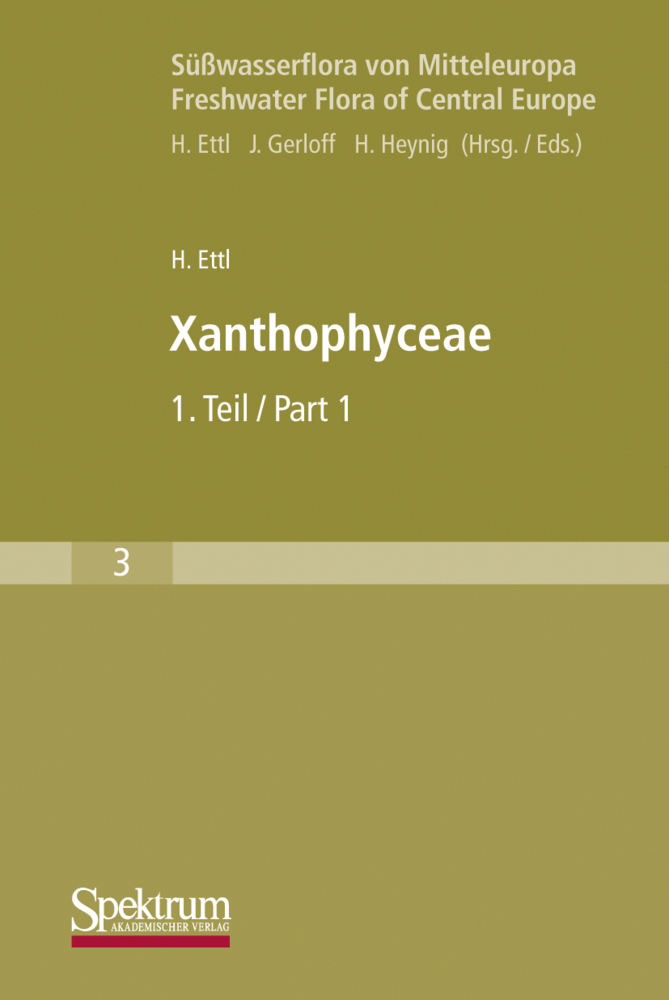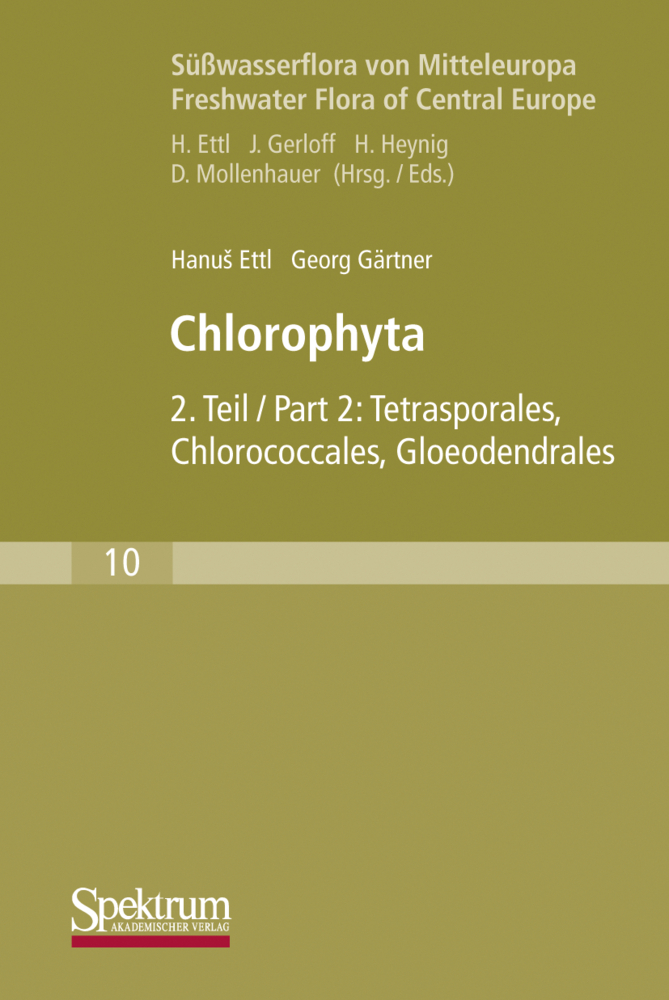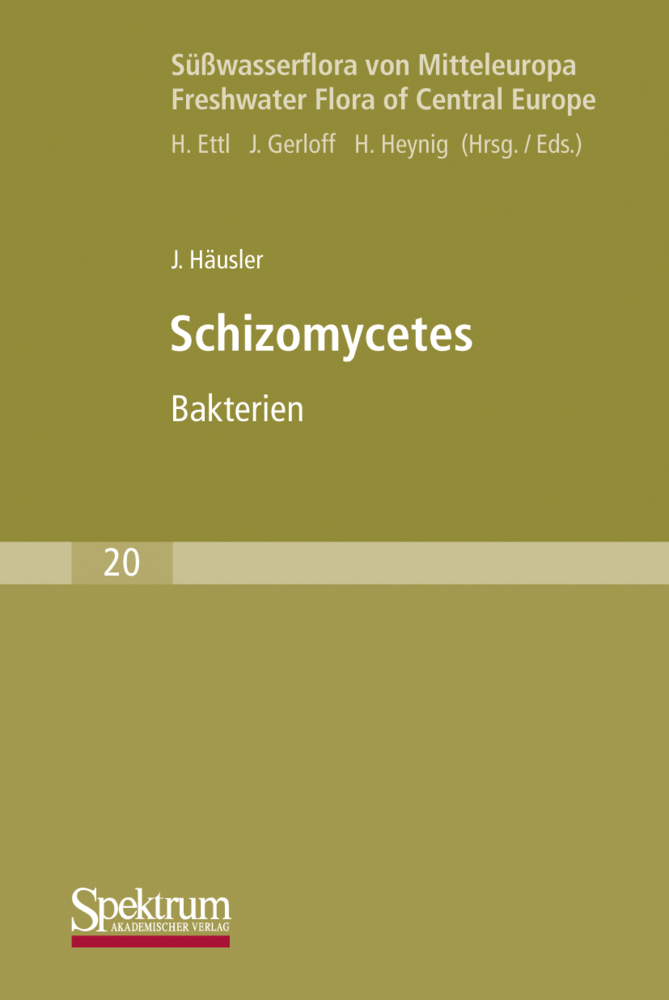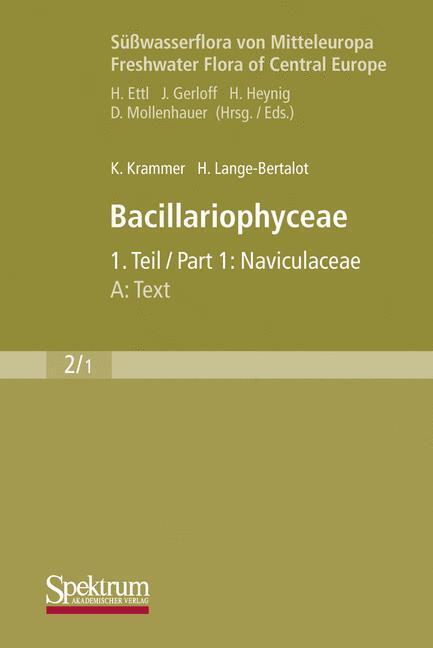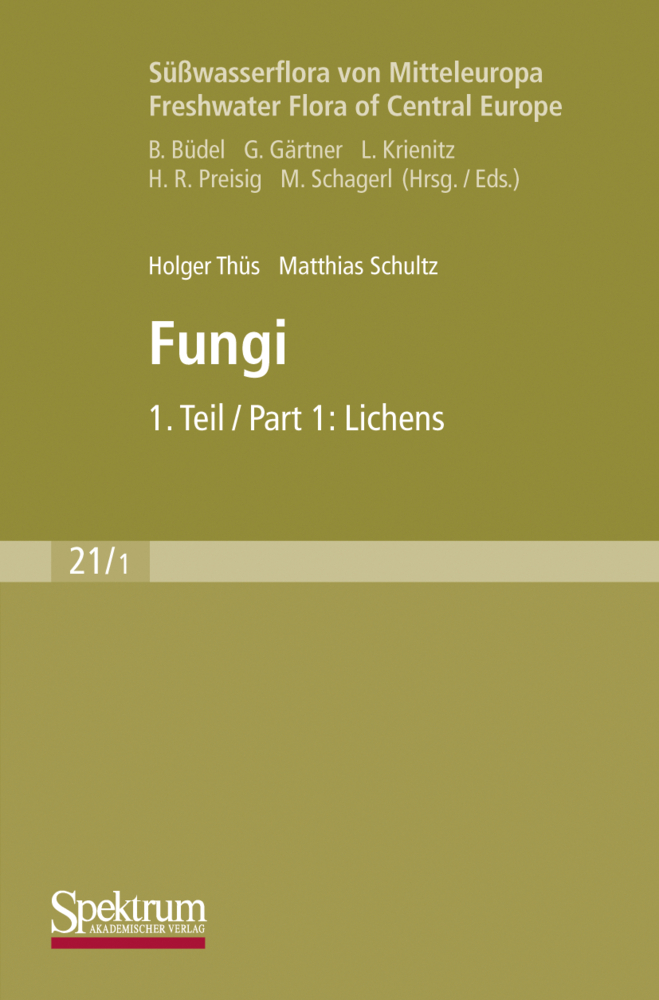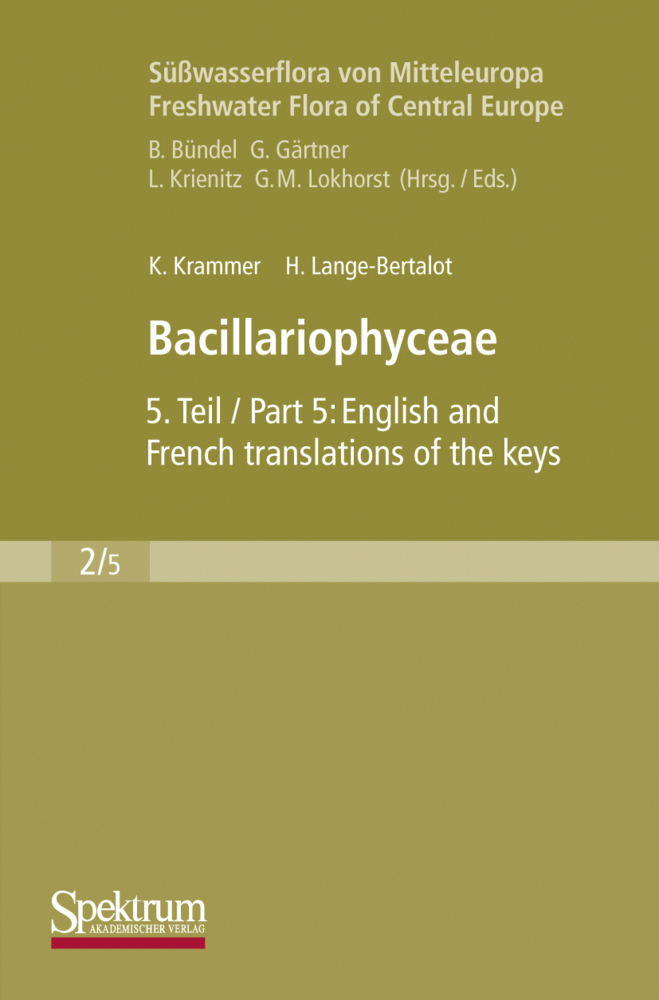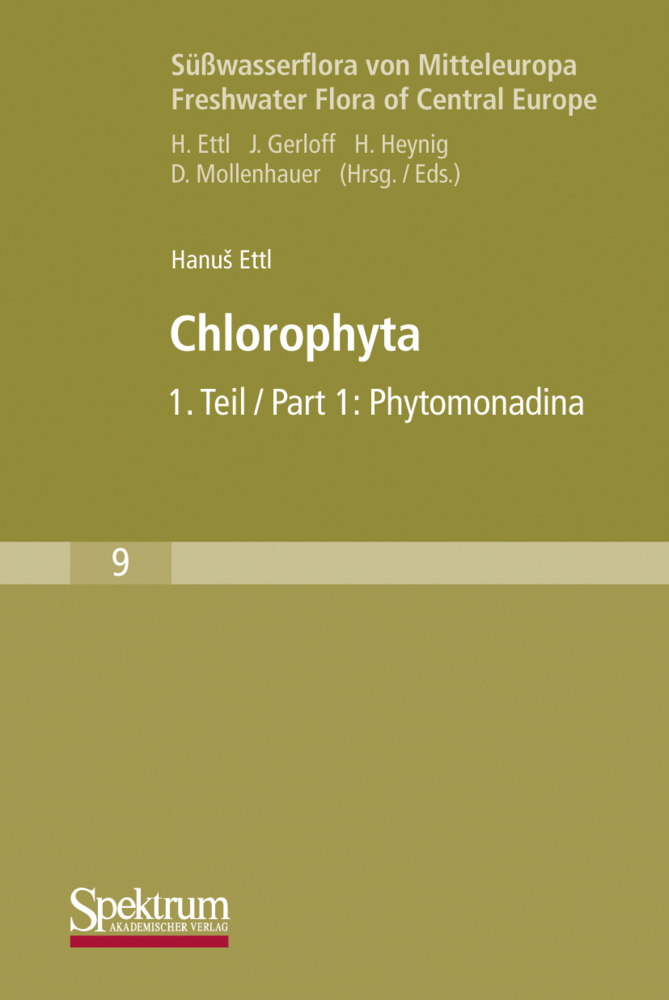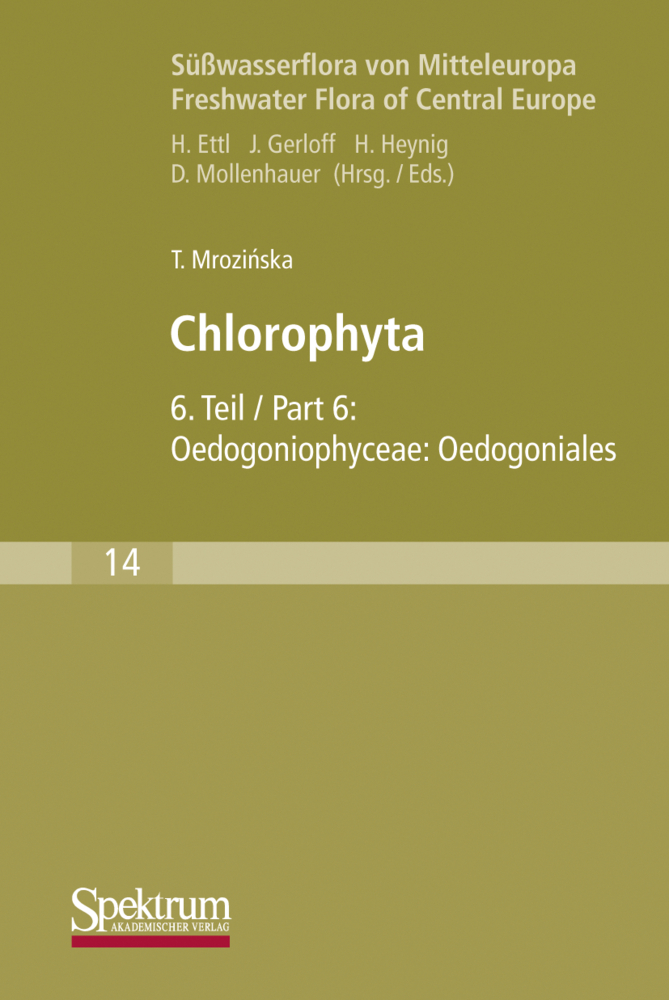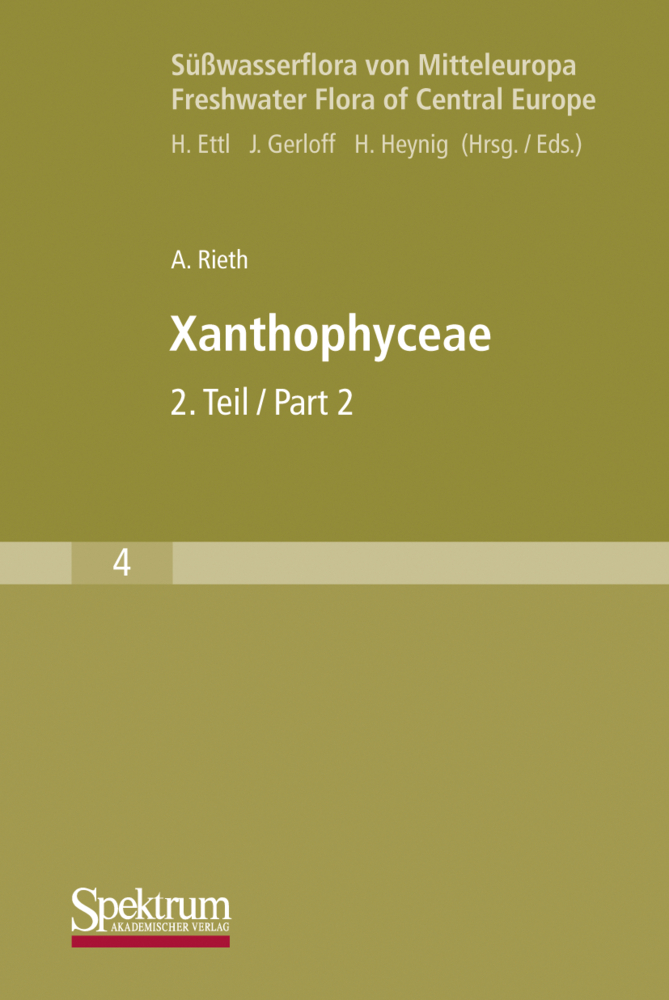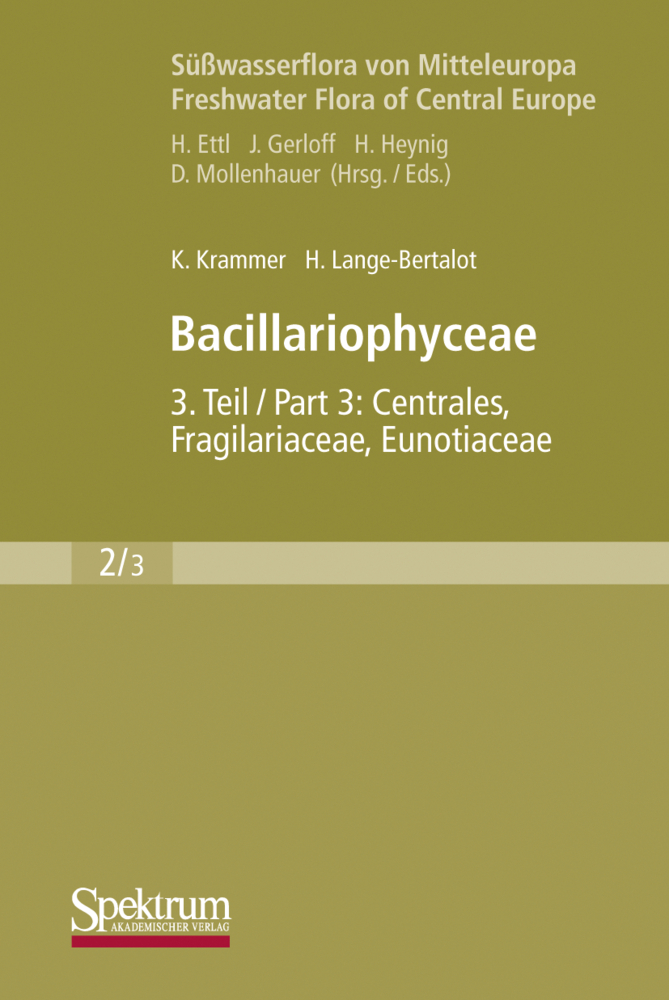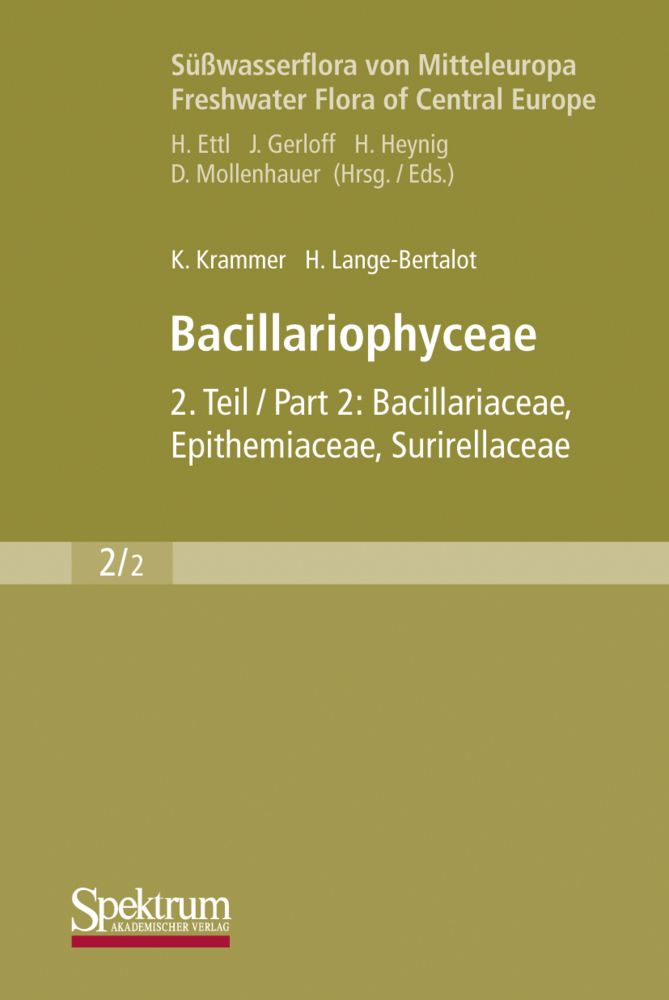Süßwasserflora von Mitteleuropa, Bd. 03: Xanthophyceae
Süßwasserflora von Mitteleuropa, Bd. 03: Xanthophyceae
Die Xanthophyceen gehören zu den Algengruppen, deren Studium in den letzten Jahrzehnten etwas weniger gefördert wurde. Im Vergleich mit den übrigen Algen ist der Zuwachs der neu beschriebenen Arten geringer. Dafür sprechen auch die wenigen Angaben über deren Verbreitung und Ökologie. Ausgenommen sind nur solche Formen, die auf den ersten Blick erkennbar sind, morphologisch auffallen und deswegen auch öfters in den Artenlisten stehen. Da die Süßwasserflora vor allem ein Bestimmungswerk ist, wurde sie in gewisser Hinsicht etwas konservativer gehalten. Ich habe von manchen neuen biochemischen und ultrastrukturellen Auffassungen der Systematik abgesehen, weil noch zu wenig Beweismaterial zusammengetragen worden ist. Weitere Untersuchungen werden möglicherweise zeigen, daß manche Xanthophyceen Grünalgen sind, die unter gewissen Umständen keine Stärke speichern und deren Chromatophoren mehr gelbgrün gefärbt sind. Dies gilt vor allem für solche Formen, bei denen weder Zoosporen noch Zysten beobachtet wurden. Zukünftige Pigmentanalysen werden zeigen, wohin diese Formen gehören. 1: Chrysophyceae und Haptophyceae 2/1: Bacillariophyceae: Naviculaceae 2/2: Bacillarioph.: Bacillariaceae, Epithemiaceae, Surirellaceae 2/3: Bacillarioph.: Centrales, Fragilariaceae, Eunotiaceae 2/4: Bacillarioph.: Achnanthaceae 2/5: Bacillarioph.: English and French translation of the keys 3/1: Xanthophyceae 4/2: Xanthophyceae 2 6: Dinophyceae Dinoflagellida 9: Chlorophyta I: Phytomonadina 10: Chlorophyta II: Tetrasporales, Chlorococcales, Gloeodendrales 14: Chlorophyta VI: Oedogoniophyceae: Oedogoniales 16: Chlorophyta VIIII: Conjugatophyceae I: Zygnemales 19/1: Cyanoprokaryota I Chroococcales 19/2: Cyanoprokaryota. Oscillatoriales 20: Schizomycetes
II. Spezieller Teil: Xanthophyceae 1. 1. Ordnung Chloramoebales. 1.1. Familie Chloramoebaceae Luther. 1.1.1. Heterochloris Pascher. 1.1.2. Chloramoeba Bohlin. 1.1.3. Anotropis Pascher. 1.1.4. Polykyrtos Pascher. 1.1.5. Chloromeson Pascher. 1.1.6. Ankylonoton Pascher. 1.1.7. Nephrochloris Geitler et Gimesi. 1.1.8. Phacomonas Lohmann. 1.1.9. Chlorokardion Pascher. 1.2. Familie Bothrochloridaceae Ettl. 1.2.1. Bothrochloris Pascher. 1.2.2. Beckingia Ruinen. 2. Ordnung Rhizochloridales. 2.1. Familie Rhizochloridaceae Pascher em. Ettl. 2.1.1. Rhizochloris Pascher. 2.1.2. Chlorarachnion Geitler. 2.2. Familie Stipitococcaceae Ettl. 2.2.1. Stipitococcus W. et G.S. West. 2.2.2. Stipitoporos Ettl. 2.2.3. Rhizolekane Pascher. 2.3. Familie Myxochloridaceae Pascher. 2.3.1. Myxochloris Pascher. 2.3.2. Chlamydomyxa Archer. 3. Ordnung Heterogloeales. 3.1. Familie Heterogloaceae Fott. 3.1.1. Heterogloea Pascher. 3.1.2. Gloechloris Pascher. 3.1.3. Helminthogloea Pascher. 3.2. FamilieMalleodendraceae Pascher. 3.3. Familie Pleurochloridellaceae Ettl. 3.4. Familie Characidiopsidaceae Ettl. 4. Ordnung Mischococcales. 4.1. Familie Pleurochloridaceae Pascher. 4.1.1. Pleurochloris Pascher.4.1.2. Chloridella Pascher. 4.1.3. Ellipsoidion Pascher. 4.1.4. Monallantus Pascher. 4.1.5. Nephrodiella Pascher. 4.1.6. Monodus Chodat. 4.1.7. Chlorocloster Pascher. 4.1.8. Pleurogaster Pascher. 4.1.9. Rhomboidella Pascher. 4.1.10. Prismatella Pascher. 4.1.11. Diachros Pascher. 4.1.12. Sklerochlamys Pascher. 4.1.13. Arachnochloris Pascher. 4.1.14. Trachycystis Pascher. 4.1.15. Chlorarkys Pascher. 4.1.16. Keriosphaera Pascher. 4.1.17. Endochloridion Pascher. 4.1.18. Akanthochloris Pascher. 4.1.19. Trachychloron Pascher. 4.1.20. Aulakochloris Pascher. 4.1.21. Chlorallantus Pascher. 4.1.22. Trachydiscus Ettl. 4.1.23. Schilleriella Pascher. 4.1.24. Pseudotetraedron Pascher. 4.1.25. Meringosphaera Lohmann em. Pascher. 4.1.26. Actinellipsoidion Ettl. 4.1.27. Skiadosphaera Pascher. 4.1.28. Vischeria Pascher. 4.1.29. Polyedriella Pascher. 4.1.30. Chlorogibba Geitler. 4.1.31. Tetraedriella Pascher. 4.1.32. Tetraplektron Fott. 4.1.33. Pseudostaurastrum Chodat. 4.1.34. Goniochloris Geitler. 4.1.35. Polygoniochloris Ettl. 4.1.36. Bracchiogonium Pascher in Ettl. 4.1.37. Isthmochloron Skuja. 4.1.38. Pseudopolyedriopsis Gollerbach. 4.2. Familie Botrydiopsidaceae Ettl. 4.2.1. Botrydiopsis Borzi. 4.2.2. Excentrochloris Pascher. 4.2.3. Chlorapion Bourrelly. 4.2.4. Perone Pascher. 4.3. Familie Botryochloridaceae Pascher. 4.3.1. Ilsteria Skuja et Pascher. 4.3.2. Tektraktis Pascher. 4.3.3. Raphidiella Pascher. 4.3.4. Heterodesmus Ettl. 4.3.5. Botryochloris Pascher. 4.3.6. Sphaerosororus Pascher. 4.3.7. Ducelliera Teiling. 4.3.8. Chlorellidiopsis Pascher. 4.3.9. Chlorellidium Vischer et Pascher. 4.3.10. Dichotomococcus Korschikoff. 4. Familie Gloeobotrydaceae Pascher. 4.4.1. Gloeoskene Fott. 4.4.2. Chlorosaccus Luther. 4.4.3. Gloeobotrys Pascher. 4.4.4. Gloeosphaeridium Pascher. 4.4.5. Chlorobotrys Bohlin. 4.4.6. Merismogloea Pascher in Ettl. 4.4.7. Asterogloea Pascher. 4.4.8. Gaumiella Bourrelly. 4.5. Familie Gloeopodiaceae Pascher. 4.6. Familie Mischococcaceae Pascher. 4.7. Familie C
Bestimmungsschlüssel für die Klassen der Algen
I. Allgemeiner Teil: 1. Abgrenzung der Xanthophyceen. 2. Bau der Xanthophyceen-Zelle: 2.1. Zellwand. 2.2. Geißelapparat. 2.3. Plasma und Kern. 2.4. Chromatophoren. 2.5. Pulsierende Vakuolen. 2.6. Assimilate und Reservestoffe. 2.7. Andere Inhaltskörper der Zelle. 3. Morphologie der Xanthophyceen. 3.1. Monadoide (begeißelte) Organisationsstufe. 3.2. Rhizopodiale (amöboide) Organisationsstufe. 3.3. Capsale (monadoid-celluläre) Organisationsstufe. 3.4. Coccale (celluläre) Organisationsstufe. 3.5. Trichale (fadenbildende) Organisationsstufe. 3.6. Siphonale (siphonoblastische) Organisationsstufe. 4. Fortpflanzung. 5. Dauerzustände. 6. Lebenszyklus. 7. Verbreitung und Ökologie. 8. Kultur, Untersuchung und Bestimmung. 9. Gliederung der XanthophyceenII. Spezieller Teil: Xanthophyceae 1. 1. Ordnung Chloramoebales. 1.1. Familie Chloramoebaceae Luther. 1.1.1. Heterochloris Pascher. 1.1.2. Chloramoeba Bohlin. 1.1.3. Anotropis Pascher. 1.1.4. Polykyrtos Pascher. 1.1.5. Chloromeson Pascher. 1.1.6. Ankylonoton Pascher. 1.1.7. Nephrochloris Geitler et Gimesi. 1.1.8. Phacomonas Lohmann. 1.1.9. Chlorokardion Pascher. 1.2. Familie Bothrochloridaceae Ettl. 1.2.1. Bothrochloris Pascher. 1.2.2. Beckingia Ruinen. 2. Ordnung Rhizochloridales. 2.1. Familie Rhizochloridaceae Pascher em. Ettl. 2.1.1. Rhizochloris Pascher. 2.1.2. Chlorarachnion Geitler. 2.2. Familie Stipitococcaceae Ettl. 2.2.1. Stipitococcus W. et G.S. West. 2.2.2. Stipitoporos Ettl. 2.2.3. Rhizolekane Pascher. 2.3. Familie Myxochloridaceae Pascher. 2.3.1. Myxochloris Pascher. 2.3.2. Chlamydomyxa Archer. 3. Ordnung Heterogloeales. 3.1. Familie Heterogloaceae Fott. 3.1.1. Heterogloea Pascher. 3.1.2. Gloechloris Pascher. 3.1.3. Helminthogloea Pascher. 3.2. FamilieMalleodendraceae Pascher. 3.3. Familie Pleurochloridellaceae Ettl. 3.4. Familie Characidiopsidaceae Ettl. 4. Ordnung Mischococcales. 4.1. Familie Pleurochloridaceae Pascher. 4.1.1. Pleurochloris Pascher.4.1.2. Chloridella Pascher. 4.1.3. Ellipsoidion Pascher. 4.1.4. Monallantus Pascher. 4.1.5. Nephrodiella Pascher. 4.1.6. Monodus Chodat. 4.1.7. Chlorocloster Pascher. 4.1.8. Pleurogaster Pascher. 4.1.9. Rhomboidella Pascher. 4.1.10. Prismatella Pascher. 4.1.11. Diachros Pascher. 4.1.12. Sklerochlamys Pascher. 4.1.13. Arachnochloris Pascher. 4.1.14. Trachycystis Pascher. 4.1.15. Chlorarkys Pascher. 4.1.16. Keriosphaera Pascher. 4.1.17. Endochloridion Pascher. 4.1.18. Akanthochloris Pascher. 4.1.19. Trachychloron Pascher. 4.1.20. Aulakochloris Pascher. 4.1.21. Chlorallantus Pascher. 4.1.22. Trachydiscus Ettl. 4.1.23. Schilleriella Pascher. 4.1.24. Pseudotetraedron Pascher. 4.1.25. Meringosphaera Lohmann em. Pascher. 4.1.26. Actinellipsoidion Ettl. 4.1.27. Skiadosphaera Pascher. 4.1.28. Vischeria Pascher. 4.1.29. Polyedriella Pascher. 4.1.30. Chlorogibba Geitler. 4.1.31. Tetraedriella Pascher. 4.1.32. Tetraplektron Fott. 4.1.33. Pseudostaurastrum Chodat. 4.1.34. Goniochloris Geitler. 4.1.35. Polygoniochloris Ettl. 4.1.36. Bracchiogonium Pascher in Ettl. 4.1.37. Isthmochloron Skuja. 4.1.38. Pseudopolyedriopsis Gollerbach. 4.2. Familie Botrydiopsidaceae Ettl. 4.2.1. Botrydiopsis Borzi. 4.2.2. Excentrochloris Pascher. 4.2.3. Chlorapion Bourrelly. 4.2.4. Perone Pascher. 4.3. Familie Botryochloridaceae Pascher. 4.3.1. Ilsteria Skuja et Pascher. 4.3.2. Tektraktis Pascher. 4.3.3. Raphidiella Pascher. 4.3.4. Heterodesmus Ettl. 4.3.5. Botryochloris Pascher. 4.3.6. Sphaerosororus Pascher. 4.3.7. Ducelliera Teiling. 4.3.8. Chlorellidiopsis Pascher. 4.3.9. Chlorellidium Vischer et Pascher. 4.3.10. Dichotomococcus Korschikoff. 4. Familie Gloeobotrydaceae Pascher. 4.4.1. Gloeoskene Fott. 4.4.2. Chlorosaccus Luther. 4.4.3. Gloeobotrys Pascher. 4.4.4. Gloeosphaeridium Pascher. 4.4.5. Chlorobotrys Bohlin. 4.4.6. Merismogloea Pascher in Ettl. 4.4.7. Asterogloea Pascher. 4.4.8. Gaumiella Bourrelly. 4.5. Familie Gloeopodiaceae Pascher. 4.6. Familie Mischococcaceae Pascher. 4.7. Familie C
| ISBN | 978-3-8274-2137-1 |
|---|---|
| Medientyp | Buch |
| Copyrightjahr | 2009 |
| Verlag | Springer Spektrum |
| Umfang | XIV, 530 Seiten |
| Sprache | Deutsch |

